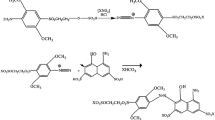Abstract
Traditionally, naturally extracted Indigo has been used for dyeing cotton. Amongst all the classes of dyes for cellulosic material, vat dyes are most widely used due to their excellent fastness properties. The vat dyeing process, depending upon the subclasses, has to go through reduction phase for solubilisation, dyeing and oxidation phases at specific conditions. Even with the advent of new techniques like the electrochemical and bacterial process, their industrial use is relatively limited. Prior investigation on bacterial reduction suggests only a few possible varieties of indigo-reducing bacteria, sources of most of which are still unknown. Also to implement this processes, they are required to be performed at higher temperatures. In the present study, we have developed a novel method of vatting and dyeing using bacterial cell lysate at room temperature followed by air oxidation. This paper also compares the newly proposed processing route with the existing conventional ones, and the experimental results have shown promising results regarding improvement in dye uptake, faster dyeing, and better levelness along with their fastness properties. Besides, the proposed process ensures energy saving, dye effluent load reduction and simplifies the existing process.
Graphical Abstract







Similar content being viewed by others
References
Aspland JR (1992) Vat dyes and their application. Text Chem Color 24(1):22–24
Bankole PO et al (2017) Degradation of indigo dye by a newly isolated yeast, Diutina rugosa from dye wastewater polluted soil. J Environ Chem Eng 5(5):4639–4648
Barik S et al (2017) Nano-Mg–Al-layered double hydroxide application to cotton for enhancing mechanical, UV protection and flame retardancy at low cytotoxicity level. Cellulose 24(2):1107–1120
Baumgarte U (1987a) Redukions-und Oxidations-Prozessebeim Färbenmit Küpenfarbbstoffen. Melliand Textilber 189(68):276–281
Baumgarte U (1987b) Developments in vat dyes and their application 1974–1986. Rev Prog Color 17(1):29–38
Bechtold T et al (1994) The reduction of vat dyes by indirect electrolysis. Color Technol 110(1):14–19
Božič D (2008) Ecological alternatives to the reduction and oxidation processes in dyeing with vat and sulphur dyes. Dyes Pigments 76(2):299–309
Božič M et al (2010) Enzymatic reduction of complex redox dyes using NADH-dependent reductase from Bacillus subtilis coupled with cofactor regeneration. Appl Microbiol Biotechnol 85(8):563–571
Brady PR (1992) Diffusion of dyes in natural fibres. Color Technol 22(1):58–78
Chakraborty J, Chavan RB (2004) Dyeing of denim with indigo. Ind J Fib Text Res 29(3):100–109
Chavan RB et al (1999) Chemical processing of handloom yarns and fabrics, 1st edn. Department of Textile Technology IIT, New Delhi
Etters JN (1995) Advances in indigo dyeing: implications for the dyer, apparel manufacturer and environment. Text Chem Color 27(2):17–22
Ferreira ES et al (2004) The natural constituents of historical textile dyes. Chem Soc Rev 33(6):329–336
Horne CM (1995) A review of vat dyeing on cotton yarns. Text Chem Color 27(12):27–30
Jena B (2015) Eco-friendly processing of textiles. Mater Today Proc 2(4–5):1776–1791
John P (2009) “Indigo-extraction” Handbook of natural colorants. Wiley, New York, pp 105–133
Kim MK (2010) A study on the dyeing conditions and properties of cotton fabric dyed with natural polygoum tinctoria. Unpublished master’s thesis, Ewha Woman’s University, Seoul
Kulandainathan MA (2007) Potentiostatic studies on indirect electrochemical reduction of vat dyes. Dyes Pigments 73(1):47–54
Milanović V et al (2017) Insight into the bacterial diversity of fermentation woad dye vats as revealed by PCR-DGGE and pyrosequencing. J Ind Microbiol Biotechnol 44(7):997–1004
Mohanty S et al (2014) The Atri hot spring in Odisha—a natural ecosystem for global warming research. Int J Geol Earth Environ Sci 4(1):85–90
Nicholson SK, John P (2004) Bacterial indigo reduction. Biocatal Biotransform 22(5–6):397–400
Nicholson SK, John P (2005) The mechanism of bacterial indigo reduction. Appl Microbiol Biotechnol 68(1):117–123
Padden AN et al (2000) Indigo-reducing Clostridium isatidis isolated from a variety of sources, including a 10th-century viking dye vat. J Archaeol Sci 27(10):953–956
Park S (2012) Isolation and characterization of alkaliphilic and thermotolerant bacteria that reduce insoluble indigo to soluble leuco-indigo from indigo dye vat. J Korean Soc Appl Biol Chem 55(1):83–88
Philips D (1996) Environmentally friendly, productive and reliable: priorities for cotton dyes and dyeing processes. Color Technol 112(7–8):183–186
Pricelius S (2007) Enzymatic reduction of azo and indigoid compounds. Appl Microbiol Biotechnol 77(2):321–327
Roessler A, Jin X (2003) State of the art technologies and new electrochemical methods for the reduction of vat dyes. Dyes Pigments 59(3):223–235
Rosa JM et al (2014) Development of colors with sustainability: a comparative study between dyeing of cotton with reactive and vat dyestuffs. Text Res J 84(10):1009–1017
Shenai VA (1996) Technology of textile processing volume-VI, technology of dyeing, 7th edn. Sevak Publications, Bombay, p 211
Splitstoser JC (2016) Early pre-Hispanic use of indigo blue in Peru. Sci Adv 2(9):e1501623
Valko EI (1941) Particle size in the vat dyeing of cellulose. J Am Chem Soc 63(5):1433–1437
Vickerstaff T (1954) Physical chemistry of dyeing. Oliver and Boyd, London
Vuorema A (2008) Reduction and analysis Methods of indigo. Thesis, Department of Chemistry, University of Turku, Finland
Zollinger Z (1991) Color chemistry: syntheses, properties and applications on organic dyes and pigments, 2nd edn. VCH Publishers Inc, New York, p 496
Acknowledgments
Our sincere thanks to D.C. Handloom, Govt. of India, Ministry of Textiles for funding this research project. We express our gratitude to the textile committee, ICT, Mumbai, College of Engineering and Technology (CET, TEQIP-II), KIIT University for their kind support for testing. A Patent application titled “Improved Process for Dyeing of Textiles” has been filed at the patent office on February 16, 2015; application number ‘186/KOL/2015’.
Author information
Authors and Affiliations
Contributions
SKP, AKP and PO developed the Cell lystate bacteria for vat dyeing and planned experiments. NSS and AK also planned some experiments, conducted and prepared the manuscript draft. All authors contributed their suggestions for editing the final manuscript.
Corresponding authors
Electronic supplementary material
Below is the link to the electronic supplementary material.
Rights and permissions
About this article
Cite this article
Patra, S.K., Patra, A.K., Ojha, P. et al. Vat dyeing at room temperature. Cellulose 25, 5349–5359 (2018). https://doi.org/10.1007/s10570-018-1901-5
Received:
Accepted:
Published:
Issue Date:
DOI: https://doi.org/10.1007/s10570-018-1901-5



